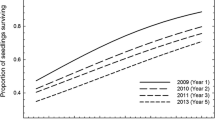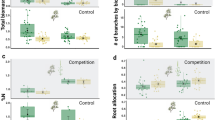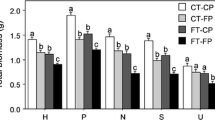Abstract
Loblolly pine seedlings of five half-sib families were grown under ambient, subambient (approximately 0.6 × ambient), and elevated [ambient + 60 ppb O3 (120 μg m−3)] O3 levels for one growing season in open-topped chambers. Diameter and height of the seedlings were measured periodically over the growing season, and above ground and below ground biomass were determined at harvest. Significant genetic differences were found in above ground volume (D 2H) 1 mo after 03 fumigation began and continued until harvest. Biomass of secondary needles and coarse and fine roots also differed significantly among families. Elevated O3 resulted in significantly decreased D 2H and secondary needle biomass relative to seedlings grown in ambient air. Seedlings receiving subambient O3 levels were intermediate in size, but were not significantly different from seedlings fumigated at ambient O3 levels. Root and stem biomass did not differ significantly among treatments. A significant interaction of O3 and genotype was detected, suggesting that the response of loblolly pine to O3 is influenced by genotype.
Similar content being viewed by others
References
Adams, M. B. and Taylor, G. E., Jr.: 1987, ‘Effects of Ozone on Forest in the Northeastern United States’, in Proceedings Conference on Ozone Risk Communication, sponsored by Northeast Regional Environmental Public Health Center, Environmental Protection Agency, April 21–27, 1987 (in press).
Boyer, J. N., Houston, D. B., and Jensen, K. F.: 1986, Eur. J. For. Path. 16, 293.
Chappelka, A. H., III and Chevone, B. I.: 1986, Can. J. For. Res. 16, 293.
Harkov, R. and Brennan, E.: 1979, J. Air Poll. Control Assoc. 29, 157.
Hatchell, G. E., Berry, C. R., and Muse, H. D.: 1985, For. Sci. 34, 419.
Jensen, K. F.: 1983, Can. J. For. Res. 12, 298.
Johnston, J. W., Jr., Shriner, D. S., and Abner, C. H.: 1986, J. Air Poll. Control Assoc. 36, 894.
Kramer, P. J. and Kozlowski, T. T.: 1979, Physiology of Woody Plants, Academic Press, New York.
Kress, L. W., Skelly, J. M., and Hinkelmann, K. H.: 1982, Can. J. For. Res. 12, 202.
Lindberg, S. R.: 1986, personal communication.
McLaughlin, S. B.: 1985, J. Air Poll. Control Assoc. 35, 512.
Meagher, J. F., Lee, N. T., Valente, R. J., and Parkhurst, W. J.: 1987, Atmos Environ 21, 605.
Miller, P. R. and Elderman, M. J. (eds.): 1976, Photochemical Oxidant Air Pollution Effects on a Mixed Conifer Ecosystem: A Progress Report. EPA-600/3-77-104, U.S. Environmental Protection Agency, Corvallis, OR.
Reich, P. B. and Amundson, R. G. 1985, Science 230, 566.
Rhoades, A., Harkov, R., and Brennan, E.: 1980, Plant Dis. 64, 1106.
Roberts, T. M., Brown, K. A., and Blank, L. W.: 1987, Methodological Aspects of the Fumigation of Forest Trees with Gaseous Air Pollutants Using Closed Chambers, paper presented at CEC Symposium on Effects of Air Pollution on Terrestrial and Aquatic Ecosystems, Grenoble, U.K., May 18–22, 1987.
Santamour, F. S., Jr.: 1969, Plant Dis. Rep. 53, 482.
Sheffield, R. M., Cost, N. D., Betchold, W. A., and McClure, J. P.: 1985, Pine Growth Reductions in the Southeast, USDA Forest Service Resource Bull. SE-83, Southeastern Forest Experiment Station, USFS, Asheville, NC.
Skelly, J. M.: 1980, ‘Photochemical Oxidant Impact on Mediterrean and Temperate Forest Ecosystems: Real and Potential Effects’, in P. R. Miller (ed.), Effects ofAir Pollutants on Mediterranean and Temperate Forest Ecosystems. Pacific Southwest Forest and Range Experiment Station, USFS, Berkeley, CA.
Skokal, R. R. and Rohlf, F. J.: 1969, Biometry: The Principles and Practice of Statistics in Biological Research, W. H. Freeman and Co., San Fransisco.
Taylor, G. E., Jr. and Norby, R. J.: 1985, ‘The Significance of Elevated Levels of Ozone on Natural Ecosystems of North America’, in S. D. Lee (ed.), 1985, International Specialty Conference on Evaluation of the Scientific Basis for Ozone/Oxidant Standard, Air Poll. Control, Assoc., Pittsburgh.
Wang, D., Bormann, F. H., and Karnosky, D. F.: 1986a, Env. Sci. Tech. 20, 1122.
Wang, D., Karnosky, D. F., and Bormann, F. H.: 1986b, Can. J. For. Res. 16, 47.
Author information
Authors and Affiliations
Additional information
Research sponsored by Tennessee Valley Authority/Electric Power Research Institute under Interagency Agreement No. TVA 1610-1610-A1 with the U.S. Department of Energy under contract DE-AC05-840R21400 with Martin Marietta Energy Systems, Inc.
Publication No. 3028, Environmental Sciences Division, ORNL.
Rights and permissions
About this article
Cite this article
Adams, M.B., Kelly, J.M. & Edwards, N.T. Growth of Pinus Taeda L. Seedlings varies with Family and ozone exposure level. Water Air Soil Pollut 38, 137–150 (1988). https://doi.org/10.1007/BF00279592
Received:
Revised:
Issue Date:
DOI: https://doi.org/10.1007/BF00279592




